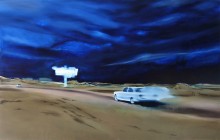TINA LÜERS
NIGHT VISIONS
 Layers of darkness are gathered, one upon the other, yielding night. A sunken depth resides at the bottom, now dark blue, now brown, or green, rarely pitch black. Pads of glistening yellow are floating atop, like islands. Their gleam reaches the unlit base of the clouded night. It remains on top and freezes into an echo of human presence.
Layers of darkness are gathered, one upon the other, yielding night. A sunken depth resides at the bottom, now dark blue, now brown, or green, rarely pitch black. Pads of glistening yellow are floating atop, like islands. Their gleam reaches the unlit base of the clouded night. It remains on top and freezes into an echo of human presence.
Esther Horn’s Night Visions represent a kind of painting that originates in light and colour. Yet, on that basis, it develops its own nocturnal language. If not altogether absent, the few human figures appear dimly under the starless sky, anticipated in cars and campers, suspected behind steamy phone booth windows. A secret lies quietly in the vast spaces and landscapes. Whether untrodden snow, fallow plains or a threatening and motionless void: the frozen moments, much like film stills, appear as motifs from a sequence of ambiguous continuity. The night may hold defenceless terror – or savage realities. Human presence, if not visible, is immediately sensible. In “american_fake”, a dark sky meets the untilled paths of a sabulous landscape. A bright car passes through the night: Where bound, that late, that far?
 No less present is the materiality of painting, givingnames to subject matter by decomposing its forms. It is the tangibility of matter that delivers the paintings’ iconicity. Weightlessly translucent spots yield clearance. They grant transparency, deny the simulacrum and refer back to the medium, the painting itself. Layers, glazes, covering gestures, smooth and fissured surfaces give expression to the materiality of the process, the adhesion to material. Darkness runs into the bushes from above. No moon is visible in the polar night, no gloom illuminates the dark. Only the snow, reflecting a light blue, gets a share of reverberation from the solar winds. They interfere with the earth’s magnetic field, unsettling it. With a disquieting intensity, Esther Horn generates the world from the colour space and hands it back to the beholder, to be perceived.
No less present is the materiality of painting, givingnames to subject matter by decomposing its forms. It is the tangibility of matter that delivers the paintings’ iconicity. Weightlessly translucent spots yield clearance. They grant transparency, deny the simulacrum and refer back to the medium, the painting itself. Layers, glazes, covering gestures, smooth and fissured surfaces give expression to the materiality of the process, the adhesion to material. Darkness runs into the bushes from above. No moon is visible in the polar night, no gloom illuminates the dark. Only the snow, reflecting a light blue, gets a share of reverberation from the solar winds. They interfere with the earth’s magnetic field, unsettling it. With a disquieting intensity, Esther Horn generates the world from the colour space and hands it back to the beholder, to be perceived.
Translation by Samuel Horn